Related Research Articles

The 7th century is the period from 601 through 700 in accordance with the Julian calendar in the Christian Era.

Srivijaya, also spelled Sri Vijaya, was a Hindu-Buddhist thalassocratic empire based on the island of Sumatra that influenced much of Southeast Asia. Srivijaya was an important centre for the expansion of Buddhism from the 7th to 11th century AD. Srivijaya was the first polity to dominate much of western Maritime Southeast Asia. Due to its location, Srivijaya developed complex technology utilizing maritime resources. In addition, its economy became progressively reliant on the booming trade in the region, thus transforming it into a prestige goods-based economy.

Maṇḍala is a Sanskrit word meaning 'circle'. The mandala is a model for describing the patterns of diffuse political power distributed among Mueang or Kedatuan (principalities) in medieval Southeast Asian history, when local power was more important than the central leadership. The concept of the mandala balances modern tendencies to look for unified political power, e.g. the power of large kingdoms and nation states of later history – an inadvertent byproduct of 15th century advances in map-making technologies. In the words of O. W. Wolters who further explored the idea in 1982:
The map of earlier Southeast Asia which evolved from the prehistoric networks of small settlements and reveals itself in historical records was a patchwork of often overlapping mandalas.
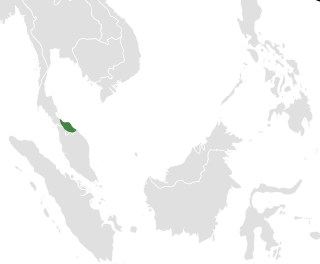
Langkasuka was an ancient Hindu-Buddhist kingdom located in the Malay Peninsula. Langkasuka flourished from the 200s to the 1500s as the oldest kingdom in the Malay Peninsula, believed to have been established by descendants of Ashoka the Great. The name is Sanskrit in origin; it is thought to be a combination of langkha for "resplendent land" -sukkha for "bliss". The kingdom, along with Old Kedah, is among the earliest kingdoms founded on the Malay Peninsula. The exact location of the kingdom is of some debate, but archaeological discoveries at Yarang near Pattani, Thailand suggest a probable location. The kingdom is proposed to have been established in the 1st century, perhaps between 80 and 100 AD.

The Shailendra dynasty was the name of a notable Indianised dynasty that emerged in 8th-century Java, whose reign signified a cultural renaissance in the region. The Shailendras were active promoters of Mahayana Buddhism and covered the Kedu Plain of Central Java with Buddhist monuments, one of which is the colossal stupa of Borobudur, now a UNESCO World Heritage Site.
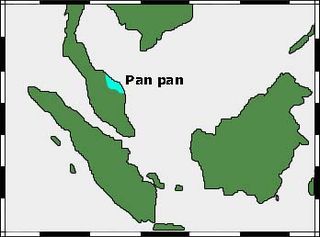
Pan Pan or Panpan was a small Hindu kingdom believed to have existed around the 3rd to 7th century CE. It is believed to have been located on the east coast of the Malay Peninsula, with opinion varying from somewhere in Kelantan or Terengganu, in modern-day Malaysia to the vicinity of Phunphin district, Surat Thani province, in modern Thailand.

The Mataram kingdom ; also known as Medang kingdom was a Javanese Hindu-Buddhist kingdom that flourished between the 8th and 11th centuries. It was based in Central Java, and later in East Java. Established by King Sanjaya, the kingdom was ruled by the Shailendra dynasty and Ishana dynasty.

The Sanjaya dynasty was a Javanese dynasty which ruled the Mataram Kingdom in Java during the first millennium CE. The dynasty promoted Hinduism on the island.

Tambralinga was an Indianised Malay kingdom located on the Malay Peninsula, existing at least from the 2nd to 13th centuries CE. It possibly was under the influence of Srivijaya for some time, but later became independent from it or were generally allies rather than conqueror and vassal. The name had been forgotten until scholars recognized Tambralinga as Nakhon Si Thammarat. In Sanskrit and Prakrit, tām(b)ra means "copper", "copper-coloured" or "red" and linga means "symbol" or "creation", typically representing the divine energy of Shiva.
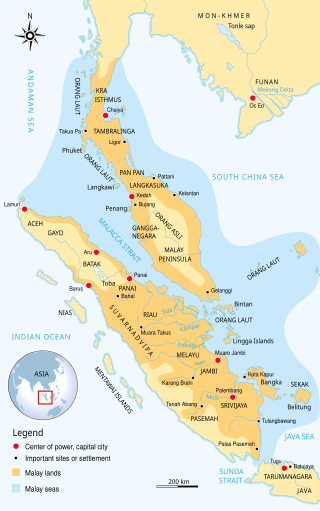
The Melayu Kingdom was a classical Buddhist kingdom located in what is now the Indonesian province of West Sumatra and Jambi.
Dharmasraya is the capital of the 11th century Buddhist polity known as Melayu Kingdom, based on the Batanghari river system in modern-day West Sumatra and Jambi, on the island of Sumatra, Indonesia. The kingdom itself could be identified by the name of its capital Dharmasraya or by the name Bhumi Malayu or Suvarnnabhumi according to Padang Roco Inscription.
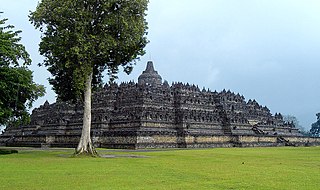
Samaratungga was the head of the Sailendra dynasty which ruled the Mataram Kingdom and Srivijaya in the 8th and 9th centuries. He was the successor of King Indra, and his name was mentioned in the Karangtengah inscription dated 824 CE as the constructor of a sacred Buddhist building called Venuvana to place the cremated ashes of his predecessor King Indra of Sailendra. During his administration, he initiated the construction of a massive Buddhist monument Borobudur. Samaratungga married Dewi Tara, the princess of Srivijayan ruler Dharmasetu, which created a close political alliance between the Sailendras and Srivijaya.
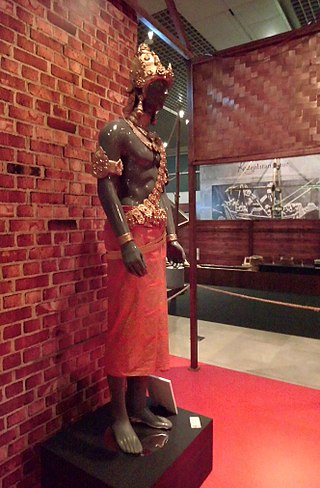
Balaputradewa was the maharaja of Srivijaya in the 9th century CE as well as the former head of the Sailendra dynasty. He was the youngest son of the preceding Sailendran maharaja, Samaratunga, through marriage with Dewi Tara who was in turn the daughter of another maharaja, Dharmasetu of Srivijaya.
The Sojomerto inscription is an inscription discovered in Sojomerto village, Reban, Batang Regency, Central Java, Indonesia. Written in Old Malay using the Kawi script, it was initially dated to c. the 7th century, but later redated, on palaeographic grounds, to the early 9th century. The inscription is currently in situ or on location.

Southeast Asia was in the Indian sphere of cultural influence from 290 BCE to the 15th century CE, when Hindu-Buddhist influences were incorporated into local political systems. Kingdoms in the southeast coast of the Indian subcontinent had established trade, cultural and political relations with Southeast Asian kingdoms in Burma, Bhutan, Thailand, the Sunda Islands, Malay Peninsula, Philippines, Cambodia, Laos, and Champa. This led to the Indianisation and Sanskritisation of Southeast Asia within the Indosphere, Southeast Asian polities were the Indianised Hindu-Buddhist Mandala.

In 1025 CE, the Chola Emperor Rajendra I launched naval raids on Srivijaya in maritime Southeast Asia, leading to the fall of the Sailendra Dynasty of Srivijaya.

Mauli was a dynasty of kings that ruled the Bhumi Malayu or Dharmasraya kingdom, centered in the Batanghari river system, from the 11th century to the 14th century. Most Mauli kings were Mahayana—Vajrayana Buddhists.
Dharanindra or commonly known as King Indra was the ruler of the Sailendra dynasty who was the Emperor of Mataram in Central Java and Srivijaya in South Sumatera. Dharanindra was the successor of Panangkaran, he ruled the kingdom in the period 775—800. He was mentioned as a great conqueror and credited for Sailendra's overseas campaign.
Ligor inscription is an 8th-century stone stele or inscription discovered in Ligor, Nakhon Si Thammarat, Southern Thailand Malay Peninsula. This inscription was written and carved on two sides, the first part is called Ligor A inscription, or also known as Viang Sa inscription, while on the other side is called the Ligor B inscription written in Kawi script dated 775 CE. The Ligor B inscription was probably written by Mahārāja dyāḥ Pañcapaṇa kariyāna Paṇaṃkaraṇa (Panangkaran), king of Shailendra dynasty. This inscription was connected to the kingdom of Srivijaya and the Shailendra dynasty.

The old Pahang kingdom was a historical Malay polity centred in the Pahang region on the east coast of the Malay Peninsula. The polity appeared in foreign records from as early as the 5th century and at its height, covered much of modern state of Pahang and the entire southern part of the peninsula. Throughout its pre-Melakan history, Pahang was established as a mueang or naksat of some major regional Malayic mandalas including Langkasuka, Srivijaya and Ligor. Around the middle of the 15th century, it was brought into the orbit of Melaka Sultanate and subsequently established as a vassal Muslim Sultanate in 1470, following the coronation of the grandson of the former Maharaja as the first Sultan of Pahang.